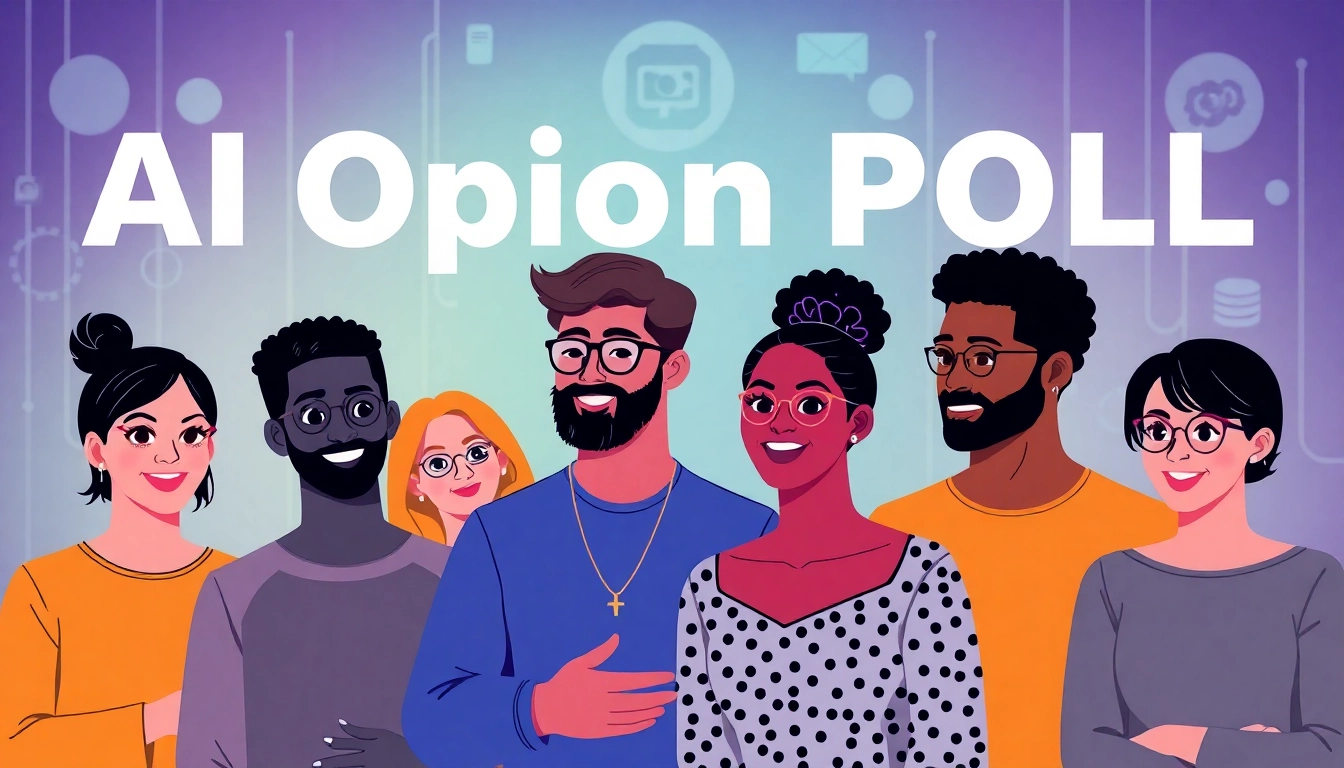Introduction to AI Opinion Polls
In the age of digital transformation, understanding public perceptions of artificial intelligence is more crucial than ever. AI opinion polls serve as a powerful tool for gathering insights into how different demographics perceive AI technologies. As various sectors integrate AI into their operations, it becomes imperative to gauge public sentiment accurately. The AI opinion poll is essential not just for businesses but also for policymakers and technologists aiming to align AI advancements with the public’s expectations and concerns.
What is an AI Opinion Poll?
An AI opinion poll is a survey designed to capture the attitudes, beliefs, and perceptions of individuals or groups regarding artificial intelligence technologies. These polls can cover various aspects, such as the perceived benefits and drawbacks of AI, trust in AI systems, and the ethical implications of AI usage. Typically, opinion polls employ diverse methodologies ranging from online surveys to telephone interviews, reaching a broad audience to gather representative data.
Significance of Public Opinion
The significance of public opinion cannot be overstated when it comes to AI. As AI technologies evolve, public sentiment influences the pace of adoption and regulation. Insights from opinion polls can highlight which aspects of AI spark excitement and which provoke fear. For instance, a recent survey indicated that 52% of Americans expressed more concern than excitement about AI in their daily lives, reflecting a significant need for ongoing dialogue about its implications. Understanding these sentiments is essential for developing AI that aligns with ethical standards and societal values.
Trends in AI Adoption and Skepticism
The trends surrounding AI adoption are complex, often marked by a duality of enthusiasm and skepticism. Rapid advancements, particularly in areas such as machine learning and automation, have led to widespread adoption across industries. However, growing public skepticism exists about job displacement, privacy concerns, and the misuse of AI technologies. Recent findings show that 40% of Americans believe AI will negatively impact society, a statistic that underscores the urgent need for transparency and education surrounding AI deployment. By analyzing trends in AI opinion polls, stakeholders can identify areas needing action and address the public’s concerns more effectively.
The Structure of Effective AI Opinion Polls
Designing effective AI opinion polls requires careful planning and consideration of various factors. From formulating survey questions to analyzing the collected data, each step plays a vital role in shaping the quality and reliability of the insights garnered from these polls.
Designing Survey Questions
The design of survey questions is critical to obtaining meaningful responses. Poll designers should aim for clarity and neutrality in phrasing to avoid biased answers. For instance, instead of asking, “Do you think AI will take your job?” a more neutral question would be, “What impact do you believe AI will have on employment opportunities?” This approach encourages respondents to consider various potential scenarios rather than leading them toward a specific emotional response. Additionally, using a mix of qualitative and quantitative questions can enrich the data. While yes/no or likert scale questions provide quantifiable metrics, open-ended questions offer insights into the reasoning behind the respondents’ opinions.
Sampling Methods
The choice of sampling methods impacts the generalizability of the findings. Random sampling is often the gold standard for achieving representative results, minimizing bias by providing each member of the population an equal chance of selection. However, researchers must also consider stratified sampling methods that ensure all relevant demographics are included. For example, if a survey aims to capture opinions from a specific age group or profession, ensuring representative samples from those groups is essential for accuracy.
Analyzing Data for Actionable Insights
Once data is collected, analyzing it effectively is paramount. Researchers often utilize statistical analysis tools to detect patterns and correlations within the data. For example, understanding not only how many respondents favor or oppose AI but also segmenting these opinions by age, gender, or socioeconomic status can reveal deeper insights. Furthermore, data visualization tools can help stakeholders interpret complex datasets through charts and graphs, making the information more accessible. Identifying actionable insights can then guide strategic decisions regarding AI development, marketing, and educational outreach.
Key Findings from Recent AI Opinion Polls
The insights gathered from recent AI opinion polls offer a comprehensive view of the public’s attitudes toward AI technology. These findings highlight key concerns, perceived benefits, and areas where further education may be necessary.
Current Sentiments Towards AI Technology
Current sentiments towards AI technology are indeed mixed. While a portion of the population expresses optimism regarding AI’s potential to enhance productivity and improve quality of life, many remain apprehensive about its broader societal implications. Surveys reveal that 72% of respondents view the potential impact of AI on misinformation negatively, indicating an underlying fear about how AI technologies could affect trust in information and media. These sentiments highlight the critical need for responsible AI development and robust frameworks to mitigate negative outcomes.
Concerns About AI Impact on Employment
One of the most pressing issues echoed in opinion polls is the concern over AI’s impact on employment. Many workers fear that automation and AI will lead to job losses, particularly in sectors like manufacturing and services. The findings from Gallup reveal that a significant majority of adults believe AI will contribute to job displacement. This reflection of public anxiety illustrates the necessity for policymakers and businesses to develop strategies that prioritize workforce retraining and reskilling. Moreover, addressing these concerns proactively can lead to smoother transitions as AI technologies become more predominant in workplaces.
Diversity in Public Responses
Diversity in responses to AI opinion polls paints a complex picture that is often influenced by factors like demographics, occupation, and education level. For example, studies have shown differences in opinion based on gender, with women frequently expressing more caution towards AI than men. Understanding these nuances allows stakeholders to tailor their strategies accordingly. For instance, educational programs aimed at increasing AI literacy might need to cater differently to varied demographic groups to effectively address their specific concerns and excite their interest.
Implications of AI Opinion Poll Results
The results of AI opinion polls have significant implications, influencing everything from policymaking to educational initiatives. Stakeholders across various sectors can leverage this data to make informed decisions that resonate with public sentiment.
Influence on Policymaking and Regulations
Public sentiment gathered from AI opinion polls heavily influences policymakers as they craft regulations surrounding AI technologies. Insights from recent polls indicate widespread concern over ethical considerations, such as data privacy and algorithmic bias, which policymakers must address through comprehensive regulations. A responsive regulatory framework will not only protect consumers but also foster an environment conducive to innovation. Engaging with the public through these polls allows policymakers to understand which issues resonate most, facilitating effective laws that reflect societal values.
Guiding Future AI Development
AI developers need to consider public opinions as they design and launch new technologies. The feedback from sentiment analysis can guide the focus of development work to better align products with user expectations. For example, if public surveys indicate a strong desire for transparency in AI algorithms, developers can prioritize creating solutions that offer users insight into how decisions are made. This user-centered approach not only enhances product acceptance but also establishes trust between the developer and the consumer.
Education and Public Awareness Initiatives
There is a clear need for increased education and public awareness initiatives surrounding AI. As opinion polls demonstrate varying levels of understanding about AI’s capabilities and limitations, stakeholders can initiate targeted education campaigns to raise awareness. Programs that provide insights into AI literacy and address misconceptions about its impacts will be essential in building public confidence. Workshops, community events, and digital resources can serve as platforms to engage in meaningful conversations about AI, ultimately fostering a more informed citizenry prepared to embrace the future of technology.
Engaging with AI Opinions: Best Practices
To effectively engage with AI opinions and integrate the insights they provide, organizations must adopt best practices that create a continuous feedback loop between themselves and their stakeholders.
Collecting Feedback from Users
Collecting feedback from users is essential for understanding public sentiment and adapting strategies accordingly. Regularly implementing follow-up surveys can provide ongoing insights that keep organizations aligned with user expectations. Additionally, interactive platforms where users can voice their opinions and share experiences can enhance consumer engagement. These platforms foster a sense of community and ownership, encouraging users to contribute actively to the development and refinement of AI technologies.
Integrating Poll Results in Business Strategy
To capitalize on the insights gained from AI opinion polls, organizations should integrate these findings into their broader business strategies. By aligning their objectives with public sentiment, businesses can enhance customer satisfaction and loyalty. For instance, if surveys indicate a preference for ethical AI practices, companies can proactively market their commitment to responsible AI use, differentiating themselves from competitors. This data-driven approach leads to a more responsive business model, enhancing the organization’s reputation and viability in the market.
Fostering Community Conversations
Fostering community conversations around AI can bridge the gap between technologists and the general public. Hosting forums, webinars, or local meet-ups provides platforms for dialogue where concerns can be addressed and ideas exchanged. Engaging with diverse community members ensures that a variety of perspectives are considered in the AI development process, enriching the conversation around responsible AI usage. By building inclusive channels for dialogue, organizations can create a more robust ecosystem for AI acceptance and growth.



